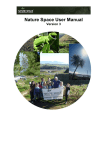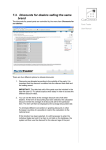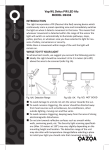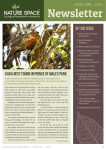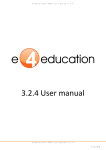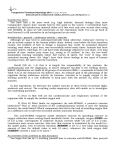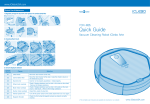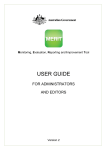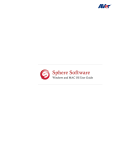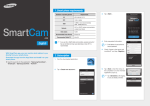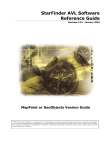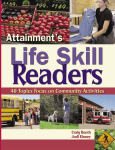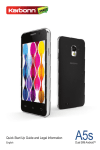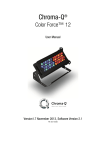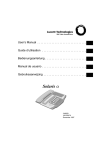Download Nature Space User Manual
Transcript
Nature Space User Manual Version 2 Nature Space User Manual version 2 1. Getting started / background information..............................................................................2 2. Logging in and out and Passwords........................................................................................2 2.1 Logging in and out 2 2.2 Changing your password 3 2.3 Request a new password 4 2.4 Changing your group email address 4 3. Editing group content..............................................................................................................5 3.1 Editing your group page 5 3.2 Group Settings 6 4. Creating group content............................................................................................................7 4.1 Creating pages / page types 7 4.1a Group page audience / viewing permissions 8 4.1b Editing group pages 8 4.2 Document Group page 9 4.3 Group data pages 9 4.4 Photopoints / Galleries 10 4.5 Events 10 4.6 File browser 10 4.6a Uploading to your file browser 10 4.6b Deleting files in your file browser 11 4.6c Opening files from file browser 12 4.6d Saving images from the file browser 12 4.6e Inserting images or files in text 13 5. Working with photos / images.................................................................................................13 5.1 Resizing photos prior to upload / background information 13 5.1a Image resizing software 14 5.2 Image field images 14 5.3 Inline images 15 6. Copyright and disclaimer.........................................................................................................18 1 1. Getting started / background information For the purposes of this document we are logged in as the Whareroa Guardians Community Trust restoration group. This guide assumes you have already had your group (and username / password) set up for you by the Nature Space team. 2. Logging in and out and Passwords 2.1 Logging in and out To login type www.naturespace.org.nz into the address bar in your browser (Internet Explorer, Firefox, Chrome or Safari). Then press enter. Click on the Group login button. Enter your username and password and press login. Passwords are case sensitive. 2 Once you are logged in you will see the black admin tool bar appear. You will also see you have been taken to a page which shows an alphabetical list of all the groups. Scroll down to find your group and click on your group name or search for your group on the right hand side of the page using the group search tool. When you are finished editing your group / group pages click the logout link in the top right hand corner (see above). 2.2 Changing your password To change your password Click ’Group login‘ when already logged in Click on the “edit” tab 3 Type in a new password in the ’Password‘ field Then retype your new password in the “confirm password” field Click ’Save’ Now you can use your new password 2.3 Request a new password Click on ’Goup login’ Click on the ’Request new password‘ tab Type your group username or e-mail in to the empty field Click the ’E-mail new password‘ button An e-mail will appear in your inbox soon. 2.4 Changing your group email address If the email and/or the contact person for your group changes it is important to let the Nature Space team know as well as changing it on your group page. 4 3. Editing group content 3.1 Editing your group page When you click on your group it will take you to your group home page. You will see an edit tab. If you click on this tab it will allow you to edit your group page content. The edit tabs will appear on any pages that you have access to edit. When you click on the edit tab you will be taken to the edit screen for this page. Once you are in the edit screen you will be able to edit your group pages. From here you can change or fill in content as well as add images into the page’s fields. It is compulsory to fill in fields marked with a red asterisk. After you have finished making your changes click on the save button on the right hand side (there is also a save button at the bottom of the page). Once the page is saved you will be taken back to the page so that you can view your changes. 5 3.2 Group Settings When your group is created the Nature Space team will enter your group content (based on the information you have given them) and configure a number of settings for your group. These settings should not be changed under any circumstances. Please view the correct settings below. 6 4. Creating group content 4.1 Creating pages / page types Click on Content management > Create Content on the admin tool bar. You will see a list of seven different group pages on the drop down menu. The group sidebar displays links to view the group pages (underneath relevant headings). To create a group page click on the page type that you want to create e.g. History on the drop down menu. After you click a page type e.g. History. You will be taken to the page creation screen. This page will look quite similar to the edit group page screen discussed earlier in this document. You will need to add content to each of the fields. The fields with a red asterisk must be filled in. The other fields are optional. The editor works in a similar way to Microsoft Word. You can type text in the body field underneath the editor and then select text / apply formatting. If you want to copy and paste text from a Word document or web page then use the ‘paste as text’ icon. The ‘paste as text’ icon removes the formatting from the text you paste in. You may have to reformat the text to some extent, e.g. remove line breaks, create lists, make words bold. Nature Space uses a predefined set of fonts and styles for consistency. You do not have a lot of freedom in terms of font choice / formatting. After you have added all the content you want, press the save button on the right hand side (or at the bottom of the page). 7 4.1a Group page audience / viewing permissions At the bottom of all group pages is a section called groups. There are two check boxes available. Please do not uncheck these two check boxes. These options make sure your pages are visible on the website and make sure your group page is linked to your group. 4.1b Editing group pages Use the Group sidebar links to navigate to the group page that you want to edit. When you are viewing a group page the process for editing the page is the same as mentioned earlier in this document, i.e. click on the edit tab above the page title. 8 4.2 Document page Click on Content management > Create Content > Document on the admin tool bar. Fill in the necessary fields including document type. You can attach one or more files (word files or pdfs) to the Document page with the attachment field. You also have the option to change the display name for the attachment. Make sure you press save when you have finished editing the page. 4.3 Group data pages When you create a group data page you should enter the year as the name of the page. This page should contain all the data for that year. If you click view data in the group sidebar you will see a list of all of the group data pages that have been created. In the group sidebar the figures shown for Group Data e.g. 150 possums killed, aggregate all the data across all the years. On the Nature Space home page all the group data is aggregated for NZ wide totals. Data details can be added retrospectively. 9 All plants must be entered as scientific/Latin names. Type the first few letters of the name, then select from the dropdown menu. When entering birds, type the first few letters of either the English or Maori name, then select from the dropdown list. If searching for a specific species, type the family name, then select from the species options, for example: typing 'shag' will generate: 'shag, black'; 'shag, king' etc. The Group Data pages give a predefined list of bird species. If you think a bird or plant species is missing then please email [email protected] 4.4 Photopoints / Galleries The photopoints section on your group page is a convenient way to record and display monitoring data photographically. Remember that it is important to label each photo you enter accurately. Refer to the Monitoring page in the Nature Space Resource Centre for more detailed information about photopoints. Photopoints and galleries rely heavily on the use of photos. For galleries and photos it is good to use the image field to load images. This is because the first image in the ‘image’ area is used as a link to get into the gallery. Also the webpage will automatically resize the images to fit inside the web page and add thumbnails for easy access for looking though the pictures. Please see Working with photos, section,5. 4.5 Events When you create an event it will appear underlined on the group calendar and main home page calendar. You can add details of all your events and activities including working bees, public events etc. You can include text and photographs if you wish. Event details can be added retrospectively, so for example, you may wish to add photographs and data from an event or volunteer day to keep a record of your activities. 4.6 File browser In the File browser you can store photos and files which can be added to your group pages. 4.6a Uploading to your file browser Click on ’Group login‘ when already logged in Click the ’File browser’ tab Click on the ’Upload‘ button which will open an upload box 10 Type in the file location or browse for the file on your computer by clicking on the ’Browse‘ button Click the ’Upload‘ button under the field When your file is uploaded click ’x‘ to close the upload box Note: Only files with file extensions png, gif, jpg, jpeg, doc, docx, xls, xlsx, ppt, pptx, odf, ods, odp, pdf, rtf and txt can be uploaded. Files have to be under 4 MB Maximum image resolution is 800ppi x 600 ppi Only one file can be uploaded at a time 4.6b Deleting files in your file browser Files can be deleted by: Selecting file Clicking the ’delete‘ button 11 Clicking ’Ok‘ 4.6c Opening files from File browser To open files: Double click on the file you want to open Depending on the file type, the file will open new window box with ’Open‘, ’Save‘ and ’Cancel‘ buttons. The ’Open‘ button will open the file in a new window The ’Save‘ button will save the file to your computer. Note: If you make changes to files, these will not be saved to files in File browser and will have to be saved to your computer and reloaded in to the File browser, either over writing old versions or as new versions. 4.6d Saving images from the file browser To save images on to your computer: Double click on an image in the File browser 12 Right click on the image in a new window Click the ’Save as‘ button Then save it to your preferred location on your computer. Note: If you make changes to files, these will not be saved to files in File browser and will have to be saved to your computer and reloaded in to the File browser either over writing old versions or as new versions. 4.6e Inserting images or files in text If your file is already uploaded to the File browser you can insert images and files by following the instructions for inline images in section 5.3 5. Working with photos / images 5.1 Resizing photos prior to upload / background information There are two main ways of adding photos to your group page(s). The two methods are Image field images and Inline images. Below you can see an example of both. Inline images are arguably harder than image field images to add. Any field that displays the editor will give you the option of adding an inline image. Many of the group pages have image fields on them. Images must be resized before uploading to your group pages. Images that are going to be used as inline images should be 300 to 500 pixels wide. Some of the image fields will have the required image size displayed underneath the field. As a general rule of thumb resize your image field images to 750 pixels wide or less (unless otherwise specified). 13 5.1a Image resizing software There are many ways to resize your pictures on your computer. Below are some examples: -Photoshop: Photoshop has a save / export for web feature which allows you to resize / compress photos for your web pages -Pixresizer: A free PC only piece of software designed for simple image resizing -Picassa: Picassa is a free piece of software for managing your pictures. It is made by Google. -http://www.resizeyourimage.com/ :This website allows you to resize images online without having to download a programme onto your computer. There are a number of websites that allow you to resize your pictures online. These sites are often paid for by advertising. Flashing banners / links are quite common on these sites. 5.2 Image field images As mentioned earlier many of the group pages have an image field. Below is a detailed example of an image field. Some image fields allow multiple images. The example field below is from a group gallery page. Two pictures have already been added to the page. To add another image click browse > then find the picture you want to upload on your computer > then press upload. A thumbnail of the image will be displayed on the left hand side of the field. Then add a description for the image as well as the name of the photographer (this will be used as a caption or description for the image). If you want to add another image click add another item. This method is good for gallery and photopoint pages. 14 5.3 Inline images This brings up the Image Properties pop up box. Then click on the ‘Browse server’ button. 15 This will bring up the File browser on the server. Click on ‘Upload’ (top left) and then browse and upload a photo. The photo will now be shown in the file list area. While the file is selected (highlighted as blue) click the ‘Insert file’ button (the green tick). This will take you back to the image properties pop up box (see above). Click on the ‘Advanced’ button. 16 Then add an advisory title. This is the title displayed when you mouse over a picture. This is a good way to acknowledge the photo / photo source / photographer. Press ‘OK’ and you will be taken back to the ‘Edit’ page. You will now see a picture loaded in your editor area. Now save the page. 17 6. Copyright and disclaimer Disclaimer 1) The agencies managing the website disclaim any responsibility or liability for material posted on the site. 2) The agencies managing the website are not responsible for the content of other websites linked to or referenced from this website. 3) Material posted on this site by users does not necessarily reflect the views of the agencies managing the website. 4) Users must have the necessary rights to material they contribute to the website. 5) Reference to any specific commercial product, process, or service whether by trade name, trademark, manufacture, or otherwise does not constitute an endorsement or recommendation by the agencies managing this website. 6) Each page on this website must be read in conjunction with this disclaimer and any other disclaimer that forms part of it. Copyright 1) The material on the website is protected by copyright. 2) Anyone can utilise any of the material available on the website free of charge and without permission of the managing agencies provided that the source and copyright status of the material is acknowledged. 3) Sources of images appear when you roll over an image with your mouse. Privacy 1) Where users disclose information via the Add My Group page, or by other means, for inclusion in the Groups section of Nature Space, that information will be available to all visitors to the website. 2) Other personal information voluntarily provided by users (e.g. via email) will only be used by Nature Space to communicate with you and will not be disclosed to any third parties. 18



















